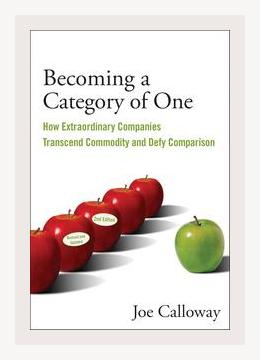Marketing and SalesBrand Management
f “Becoming a Category of One: How Extraordinary Companies Transcend Commodity and Defy Comparison” by Joe Calloway.
Summary of “Becoming a Category of One: How Extraordinary Companies Transcend Commodity and Defy Comparison”
Joe Calloway’s “Becoming a Category of One” explores how companies can stand out in crowded markets by creating exceptional brand identities that set them apart from competitors. Drawing on numerous real-world examples, Calloway outlines actionable strategies for businesses aiming to deflect comparison and achieve unique market positioning.
Introduction
Calloway starts by emphasizing the importance of not merely aiming to be better but striving to be different. The core argument is that by creating a unique identity, companies can transcend commoditization and defy direct comparison, effectively becoming their own category.
Action: Redefine how you view competition. Instead of focusing on being better than others, think about how you can be different.
Chapter 1: The Importance of Brand Distinction
Key Points:
- Unique Customer Experience: Companies must offer an experience that is so distinct it’s immediately recognizable.
-
Example: Starbucks’ ambiance and customer service make it more than just a coffee shop.
-
Emotional Connection: Create a strong emotional bond with customers.
- Example: Harley-Davidson generates fierce brand loyalty through its culture and community-building activities.
Action: Evaluate your current customer experience and identify ways to make it unique and emotionally engaging.
Chapter 2: Standing Out Through Values
Key Points:
- Core Values as Differentiators: Align business practices with core values and beliefs that resonate strongly with the target audience.
-
Example: Chick-fil-A’s adherence to its core values, such as being closed on Sundays, appeals to customers who respect such principles.
-
Authenticity: Being genuine in actions and decisions fosters customer trust and loyalty.
- Example: Patagonia’s commitment to environmental causes aligns with its customers’ values, creating a strong, loyal customer base.
Action: Identify and articulate your company’s core values and ensure they are reflected in every aspect of your business.
Chapter 3: Creating a Culture of Excellence
Key Points:
- Empowering Employees: Staff empowerment leads to better customer service and a more dynamic company culture.
-
Example: Southwest Airlines empowers its employees to make decisions that enhance the customer experience.
-
Internal Consistency: Ensure that internal operations and employee behavior are consistently aligned with the brand promise.
- Example: Ritz-Carlton’s employee training programs focus on providing a uniformly excellent guest experience.
Action: Develop training programs that empower employees and align them with the brand’s core values.
Chapter 4: Innovation as a Differentiator
Key Points:
- Product Innovation: Continuously innovate to stay ahead and provide unique solutions.
-
Example: Apple consistently sets itself apart through innovative products like the iPhone and iPad.
-
Customer-Centric Innovation: Focus on innovations that specifically address customer needs and pain points.
- Example: Amazon’s continuous improvements to its user experience, such as one-click shopping and fast delivery, keep it ahead of competitors.
Action: Invest in R&D to develop innovative products or services that solve specific customer problems.
Chapter 5: Commitment to Service
Key Points:
- Outstanding Customer Service: Exceptional service can be a key differentiator.
-
Example: Nordstrom’s renowned customer service, including their lenient return policy, sets them apart.
-
Personalization: Tailor the customer experience to individual needs and preferences.
- Example: Zappos’ personal engagement and relationship-building with customers have fostered a loyal customer base.
Action: Implement service protocols that prioritize outstanding and personalized customer experiences.
Chapter 6: Market Positioning
Key Points:
- Market Simplicity: Simplify your positioning so that it is easily understood by customers.
-
Example: Domino’s Pizza with its simple promise of “Fresh, hot pizza delivered in 30 minutes or less.”
-
Consistent Messaging: Ensure all brand communications are consistent and reinforce the market position.
- Example: FedEx’s consistent message of reliability and punctuality: “When it absolutely, positively has to be there overnight.”
Action: Simplify and clarify your market position to make it easy for customers to understand and remember.
Chapter 7: Leveraging Customer Feedback
Key Points:
- Continuous Improvement: Use customer feedback for continuous improvement.
-
Example: Toyota’s incorporation of customer and employee feedback into their manufacturing processes through the Kaizen approach.
-
Build Trust through Responsiveness: Being responsive to feedback gains customer trust.
- Example: Dell’s use of customer feedback to guide product developments, showing that they listen and care.
Action: Regularly seek and act on customer feedback to drive continuous improvements and build trust.
Chapter 8: Long-term Vision
Key Points:
- Strategic Vision: Have a clear long-term vision that drives day-to-day operations.
-
Example: Google’s vision of organizing global information guides its myriad projects and services.
-
Adapting to Change: Be willing to adapt as markets and technologies evolve.
- Example: IBM’s transformation from a hardware company to a leading provider of IT services.
Action: Develop and communicate a clear long-term vision, but remain flexible to adapt as needed.
Conclusion
Calloway concludes by reiterating that becoming a category of one is not about flashy gimmicks but about creating real, valuable differences that deeply resonate with customers. Authenticity, consistency, customer-driven innovation, and a strong value proposition are the pillars upon which extraordinary companies are built.
Final Action: Ensure your brand’s differentiators are genuine and provide real value, as authenticity is key to creating lasting customer loyalty and becoming a category of one.
By following the strategies and actions outlined by Joe Calloway in “Becoming a Category of One,” businesses can effectively stand out in any market, creating a unique identity that commands loyalty and defies direct comparison.
